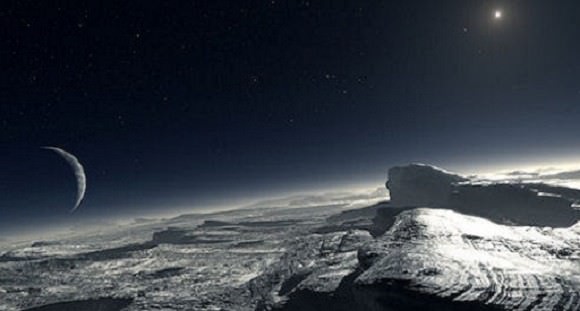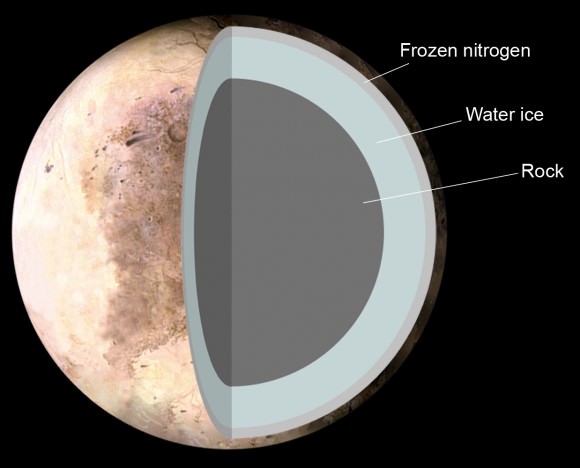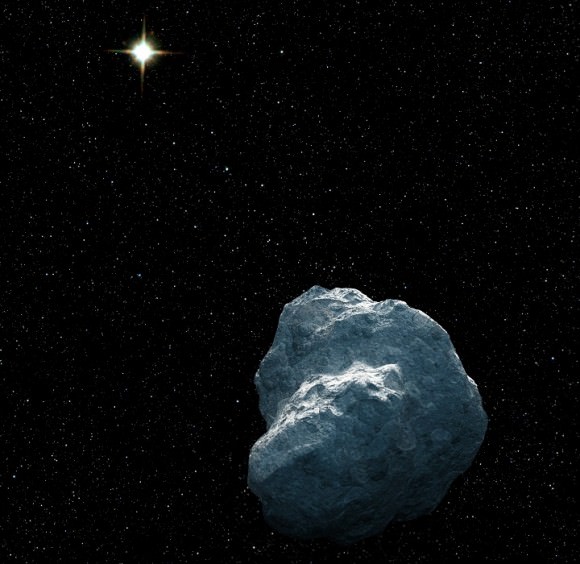First discovered in 1930, Pluto was considered to be the ninth planet in our Solar System for many decades. And though its status has since been downgraded to that of a dwarf planet, thanks to the discovery of Eris in 2004, Pluto continues to fascinate and intrigue astronomers.
And with the New Horizons mission fast approaching the planet, astronomers are eagerly anticipating the return of photographs and data that will help them answer some burning questions they have about this celestial body – not the least of which is whether or not it supports life!
Surface Conditions:
To be fair, there is virtually no chance that Pluto has life living on its surface. For starters, it orbits our Sun at extreme distances, ranging from 29.657 AU (4,437,000,000 km) at perihelion to 48.871 AU (7,311,000,000 km) at aphelion. At this distance, surface temperatures can reach as low as 33 K (-240 °C or -400 °F).
Not only does water freeze solid at these temperatures, but other liquids and gases that are present on Pluto’s surface – such as methane (CH4), nitrogen gas (N²), and carbon monoxide (CO) – also freeze solid. These compounds have much lower freezing points than water, and so the chance of life surviving under these conditions is slim to nil.

And while Pluto has a thin atmosphere, it consists mainly of nitrogen gas, methane and carbon monoxide, which exist in equilibrium with their ices on the surface. At the same time, the surface pressure ranges from s from 6.5 to 24 ?bar (0.65 to 2.4 Pa), which is roughly one million to 100,000 times less than Earth’s atmospheric pressure.
This atmosphere also undergoes transitions as Pluto gets closer and farther away from the Sun. Basically, when Pluto is at perihelion, the atmosphere freezes solid; when it is at aphelion, the surface temperature increases, causing the ices to sublimate.
As such, there is simply no way life could survive on the surface of Pluto. Between the extreme cold, low atmospheric pressure, and constant changes in the atmosphere, no known organism could survive. However, that does not rule out the possibility of life being found inside the planet.
Interior:
Like many moons and smaller planetoids in the Outer Solar System, scientists believe that Pluto’s internal structure is differentiated, with rocky material having settled into a dense core surrounded by a mantle of ice. The diameter of the core is believed to be approximately 1700 km (accounting for 70% of Pluto’s diameter), whereas the ice layer is estimated to be 100 to 180 km thick at the core-mantle boundary.

Because the decay of radioactive elements would eventually heat the ices enough for the rock to separate from them, it is possible Pluto has a liquid water ocean beneath its mantle. In 2011, planetary scientists Guillaume Robuchon and Francis Nimmo of the University of California at Santa Cruz modeled the thermal evolution of Pluto and studied the behavior of the shell to see how the surface would be affected by the presence of an ocean below.
What they determined was that the surface of Pluto would be covered by surface fractures that span the globe, owning to changes in the temperature, tensional stresses and compressional stresses of the liquid ocean below. Though no visual data exists to support the existence of such surface features, the New Horizons mission is scheduled to be providing photographic evidence of the surface shortly.
Future Possibilities:
Another possibility is that in time, conditions will change that might allow for life to exist on Pluto. While Pluto sits well beyond our Sun’s habitable zone, both the size of our Sun, and the reach of that zone, will be subject to change. In the distant future – roughly 5.4 billion years from now – our Sun will expand into a red giant, increasing the amount of energy it gives off for a period of several million of years.
Once the core hydrogen is exhausted in 5.4 billion years, the Sun will expand into a subgiant phase and slowly double in size over about half a billion years. As it expands in size, it will consume the inner planets (including the Earth), and the habitable zone will move to the outer Solar System. Even before it becomes a red giant, the luminosity of the Sun will have nearly doubled, and Earth will be hotter than Venus is today.

It will then expand more rapidly over about half a billion years until it is over two hundred times larger than it is today, and a couple of thousand times more luminous. This then starts the red-giant-branch (RGB) phase which will last around a billion years, during which time the the Sun will lose around a third of its mass.
During that time, many objects in the Kuiper Belt will warm up significantly, which will include Pluto, Eris, and countless other Trans-Neptunian Objects (TNOs).
However, given the composition of these bodies, and the relatively short window in which they will be warmer and wetter, it is not likely that life will evolve from scratch. Instead, we would probably have to transport it there from Earth, assuming humanity is still living, and seed Pluto and other surviving bodies with vegetation and terrestrial organisms.
In short, the best answer to the question – is there life on Pluto? – is a resounding maybe. Another possible answer is maybe not, with the caveat that there may indeed be life there someday (i.e. us, if we’re still around). In the meantime, all we can do is wait for data to begin coming in from New Horizons, and scan it for the telltale signs that life is indeed there right now!
We have many interesting articles about Pluto here at Universe Today. For example, here are some Interesting Facts About Pluto, How Big is Pluto, and How Long Does it Take to Get to Pluto, and Why Pluto is No Longer Considered a Planet.
To learn more, go to NASA’s New Horizons mission home page. And be sure to check out these latest images of Pluto.


ummm, reverse perihelion/freezing-aphelion/thawing
also the impact that generated Charon and other moons likely was a significant heat event that helped things along keeping warm…
” At the same time, the surface pressure ranges from s from 6.5 to 24 ?bar (0.65 to 2.4 Pa), which is roughly one million to 100,000 times less than Earth’s atmospheric pressure.”
Um… what?
Only, none of these numbers is correctly related to the others, and that’s ignoring the weird symbols and grammar stuck in. I don’t know what you were trying to say here Matt, but it needs a second look (and perhaps a quick trip over to http://www.wolfram-alpha.com).
Matt Williams, I see you’ve corrected the AU issue; is there anything we can do about the atmospheric pressure mess I mentioned before? It’s just, 6.5 bar is a bit over six times Earth surface normal, and 24 bar is ~25% of the surface atmospheric pressure of Venus, so….
Oh, come on. You’ve really never taken a character from one place, pasted it in another, and had it get garbled? 6.5 microbars is 0.65 Pa, and 100,000 Pa = 1 bar about= Earth atmospheric pressure, so the “?” has to be where they had the Greek letter mu, for “micro”.
I went to https://en.wikipedia.org/wiki/Pluto to get the pressure and behold! that’s where he got the sentence in the first place. “The surface pressure ranges from 6.5 to 24 [mu]bar (0.65 to 2.4 Pa),[113] roughly one million to 100,000 times less than Earth’s atmospheric pressure.” He screwed up the start of the copy, causing the duplication, got rid of the footnote reference and added “which is”, but the mu probably looked OK in wherever he pasted it so he went with it.
Now I’m curious. Here I paste microbar to see what it does with it: ?bar
It looks like a mu before clicking Submit.
So what you’re saying is,
A) the author didn’t bother to go back after posting to check and see if what he wrote bore any resemblance to reality (or readability, for that matter);
B) he ignored more than one comment from more than one person pointing out his errors (also plural, and still unfixed, btw) to him directly; and that most importantly,
C) it was silly of me to expect him to do anything else?
In that case, I suppose that from now on I (and all other readers of this site) should just rely on Wikipedia — as you did while correcting me — for their up-to-date information regarding Pluto and other astronomical topics, and definitely NOT on Universe Today, yes? Thanks for the advice. I will definitely keep it in mind.
I neither wrote nor implied any of that.
Certainly we should expect authors to proofread it after posting (and if he did, he didn’t read closely enough to catch that sentence). Someone should indeed look through the comments and get errors fixed, including that one.
I was not correcting your facts — they were entirely correct.
I was pointing out that what wasn’t garbled made it easy to realize what had happened. To expand, “Oh, come on. Why did you ask about the absurd numbers and not realize in a few seconds exactly how he blundered?”
“Oh, come on. Why did you ask about the absurd numbers and not realize in a few seconds exactly how he blundered?”
Quite simply, because I have no idea what Mr. Williams intended (or did not intend) to write. Unlike others, apparently, I do not have the exact surface atmospheric pressures of all the planets memorized. Thus, between the unfamiliar numbers given and the garbled text indicating the content was suspect anyway, I had no reason to ascribe ANY meaning to what was published. It was for this reason I first called the author’s attention to it.
It was only after he’d gone on to fix a separate error (the one involving a decimal versus a comma in the AU distances) and also respond to a number of other reader comments while failing to fix at least two other flawed sections (pointed out to him in those same comments) that I pinged him a second time.
In short, I see NOW how the error was likely made, but at the time, without further research, no, I had no reason to see it in just “a few seconds.” I’m fairly sure the average reader had no clue either, and THAT is what upsets me about this: not that Mr. Williams got it wrong initially, but that he has stubbornly failed to do anything about it since.
Pluto’s status has not been “downgraded.” Please seriously consider not giving undeserved privileged status to one view in this ongoing debate. Only four percent of the IAU even voted on this, and most are not planetary scientists but other types of astronomers. Their decision was immediately opposed in a formal petition by hundreds of professional astronomers led by New Horizons Principal Investigator Alan Stern. Ironically, Stern is the person who first coined the term “dwarf planet,” but he intended it to designate a third class of planets in addition to terrestrials and jovians, not to designate non-planets. The four percent of the IAU that voted on this misused his term. Given the increasing rejection of the notion that dwarf planets are not planets among planetary scientists, it is a disservice to your readers to keep repeating only one view as fact when this is far from the case.
Regarding Pluto’s atmosphere, there are now scientists who believe that atmosphere never completely freezes out, even when Pluto is farthest from the Sun.
What do you mean “debate”? Pluto is what it is, it’s a unique object like all other planets. That the IAU thoughtlessly tried to define how long a string is, was simply unscientific and a big PR blunder, there’s nothing to debate about that. Pluto is a planet. It is small and could therefore be called “dwarf” when appropriate for the context. No formal definitions are needed for doing that.
Your opinion is noted, Laurel, once again. However, we are not in the habit of altering our articles based on the opinions of individual writers or groups within the scientific community that disagree with IAU decisions or the decisions of other bodies.
When you have only 4% of the IAU that decided on a definition then that is questionable. So IAU should redo the experiment and this time with a representable sample like 50% of the scientists.
So noted, but until such time as the classification is overturned, stating how Pluto was re-designated a “dwarf planet” by the IAU is an accurate statement – regardless of whether or not people agree with it.
To say that Pluto is NOT a Planet is as CRAZY as saying that Earth is the ONLY Planet because we KNOW it has life on it and we don’t know if any of the rest do….(stupid but makes as much sense)
In a few days we will know a lot more about our beloved Pluto so all hang in there OK?
There is life: Pluto has fleas!
🙂
Third paragraph overstates by a thousandfold the distance of Pluto’s orbit from the Sun. Those AU figures need decimal points, not commas. I suspect the writer simply imported those numbers from a source (European, perhaps) that follows the opposite convention in “punctuating” large numbers.
Interesting comment. I thought this blog was followed world wide.
One needs to keep a flexible mind and accommodate multinational ways and conventions.
Matt, thank you for clearly labeling “artists’ concepts”. Too many sources are being very careless about that and there are some artist’s pictures of Pluto “out there” that are deceiving, *very deceiving*, because they are not so marked.
Not a problem. As I’m sure you know, we don’t have detailed pictures of Pluto… yet! Give New Horizons a few months to send them back though, and we’ll see what we’ll see.
Amazing! How fitting that a planet named for Greek underworld gods/figures is so mysterious and could possibly support life beneath its surface (underworld life ;). Imagine going back in time 50 yrs and telling scientists Pluto could support life.. Amazing times and great work SWRI and Alan Stern & Team, JPL, Nasa..
Nice article Matt.. So nice to see open minded and scientifically accurate news reported..
Yes, the job of headline writers is to generate clicks and views. But I am getting so very very tired of “Is There Life on ___?” articles. There’s barely any pertinent data so speculation runs rampant.